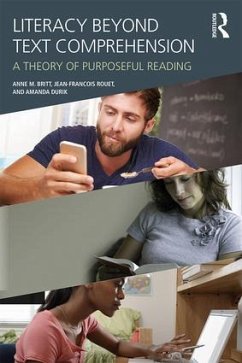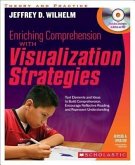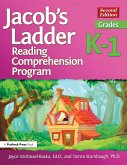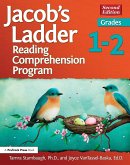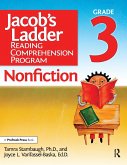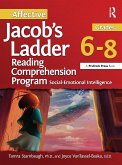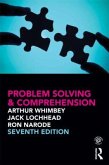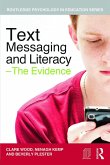M. Anne Britt, Jean-François Rouet, Amanda M. Durik
Literacy Beyond Text Comprehension
A Theory of Purposeful Reading
M. Anne Britt, Jean-François Rouet, Amanda M. Durik
Literacy Beyond Text Comprehension
A Theory of Purposeful Reading
- Broschiertes Buch
- Merkliste
- Auf die Merkliste
- Bewerten Bewerten
- Teilen
- Produkt teilen
- Produkterinnerung
- Produkterinnerung
Literacy Beyond Text Comprehension aims to systematically investigate how readers interpret reading tasks within a situation, and how that interpretation influences reading behavior and comprehension. Presenting a new model of REading as problem SOLVing (RESOLV), the authors describe reading comprehension in terms of how a reader adopts goals within a particular situation that then guide what is read, when, and how. By applying the RESOLV model to a range of reading situations, this book provides evidence to suggest that there is no unitary understanding of a task, because individuals bring…mehr
Andere Kunden interessierten sich auch für
![Enriching Comprehension with Visualization Strategies: Text Elements and Ideas to Build Comprehension, Encourage Reflective Reading, and Represent Und Enriching Comprehension with Visualization Strategies: Text Elements and Ideas to Build Comprehension, Encourage Reflective Reading, and Represent Und]() Jeffrey WilhelmEnriching Comprehension with Visualization Strategies: Text Elements and Ideas to Build Comprehension, Encourage Reflective Reading, and Represent Und26,99 €
Jeffrey WilhelmEnriching Comprehension with Visualization Strategies: Text Elements and Ideas to Build Comprehension, Encourage Reflective Reading, and Represent Und26,99 €![Jacob's Ladder Reading Comprehension Program Jacob's Ladder Reading Comprehension Program]() Joyce Vantassel-BaskaJacob's Ladder Reading Comprehension Program52,99 €
Joyce Vantassel-BaskaJacob's Ladder Reading Comprehension Program52,99 €![Jacob's Ladder Reading Comprehension Program Jacob's Ladder Reading Comprehension Program]() Tamra StambaughJacob's Ladder Reading Comprehension Program52,99 €
Tamra StambaughJacob's Ladder Reading Comprehension Program52,99 €![Jacob's Ladder Reading Comprehension Program Jacob's Ladder Reading Comprehension Program]() Joyce Vantassel-BaskaJacob's Ladder Reading Comprehension Program52,99 €
Joyce Vantassel-BaskaJacob's Ladder Reading Comprehension Program52,99 €![Affective Jacob's Ladder Reading Comprehension Program Affective Jacob's Ladder Reading Comprehension Program]() Tamra StambaughAffective Jacob's Ladder Reading Comprehension Program52,99 €
Tamra StambaughAffective Jacob's Ladder Reading Comprehension Program52,99 €![Problem Solving & Comprehension Problem Solving & Comprehension]() Arthur WhimbeyProblem Solving & Comprehension82,99 €
Arthur WhimbeyProblem Solving & Comprehension82,99 €![Text Messaging and Literacy - The Evidence Text Messaging and Literacy - The Evidence]() Clare WoodText Messaging and Literacy - The Evidence58,99 €
Clare WoodText Messaging and Literacy - The Evidence58,99 €-
-
-
Literacy Beyond Text Comprehension aims to systematically investigate how readers interpret reading tasks within a situation, and how that interpretation influences reading behavior and comprehension. Presenting a new model of REading as problem SOLVing (RESOLV), the authors describe reading comprehension in terms of how a reader adopts goals within a particular situation that then guide what is read, when, and how. By applying the RESOLV model to a range of reading situations, this book provides evidence to suggest that there is no unitary understanding of a task, because individuals bring their own goals and characteristics to the situation; as such, it demonstrates the importance of understanding how a reader (e.g., student, test-taker, employee completing a work task) represents the context and the specific assignment. Written by internationally recognized learning sciences scholars, Literacy Beyond Text Comprehension advances the state of the art in reading research, but also seeks to inform a broader range of audiences, including those interested in the teaching and the assessment of reading.
Hinweis: Dieser Artikel kann nur an eine deutsche Lieferadresse ausgeliefert werden.
Hinweis: Dieser Artikel kann nur an eine deutsche Lieferadresse ausgeliefert werden.
Produktdetails
- Produktdetails
- Verlag: Routledge
- Seitenzahl: 236
- Erscheinungstermin: 11. Juli 2017
- Englisch
- Abmessung: 229mm x 152mm x 13mm
- Gewicht: 349g
- ISBN-13: 9781138927018
- ISBN-10: 1138927015
- Artikelnr.: 43674107
- Herstellerkennzeichnung
- Books on Demand GmbH
- In de Tarpen 42
- 22848 Norderstedt
- info@bod.de
- 040 53433511
- Verlag: Routledge
- Seitenzahl: 236
- Erscheinungstermin: 11. Juli 2017
- Englisch
- Abmessung: 229mm x 152mm x 13mm
- Gewicht: 349g
- ISBN-13: 9781138927018
- ISBN-10: 1138927015
- Artikelnr.: 43674107
- Herstellerkennzeichnung
- Books on Demand GmbH
- In de Tarpen 42
- 22848 Norderstedt
- info@bod.de
- 040 53433511
M. Anne Britt is Professor in the Department of Psychology at Northern Illinois University, USA. Jean-François Rouet is Director of Research at the French National Center for Scientific Research, France. Amanda M. Durik is Associate Professor in the Department of Psychology at Northern Illinois University, USA.
Contents
List of Tables
List of Figures
Foreword
Acknowledgements
Introduction
1. The nature of contemporary reading
2. Audiences
2.1. Researchers examining discourse comprehension and academic motivation
research
2.2. Educators and instructional scientists helping to improve reading
skills and learning from reading
2.3. Designers and interpreters of assessments of reading
3. Overview of the chapters
Chapter 1. What is reading? A review of current constructs and theories
1. Reading processes and structures
2. Broadening the construct of reading comprehension: recent frameworks
2.1. Goal Focusing model
2.2. TRACE and MD-TRACE
3. Summary and conclusions
Chapter 2. Reading as a purposeful activity
1. Goals in discourse processing approaches
1.1. Reading from a perspective
1.2. Reading for general purposes
1.3. Task-oriented reading
1.4. Reading to complete inquiry tasks
2. Goals in self-regulated learning from text
2.1. Goals and standards of coherence
2.2. Goals and self-regulated learning
3. From reading goals to reading as problem solving
3.1. Reading involves the formation of non-trivial goals
3.2. Reading generally allows for more problem solving than does listening
3.3. Reading involves a series of internal states and condition-action
rules
4. Summary and conclusions
Chapter 3. A framework for reading as problem solving
1. RESOLV Processing Assumptions
1.1. Adaptive reading behavior assumption.
1.2. Limited processing resources assumption.
1.3. Feeling of knowing evaluation (FOKE) assumption.
1.4. Benefit-Cost analysis assumption.
1.5. Decision thresholds assumption
2. The RESOLV Framework
2.1. Overview
2.2. External and internal resources for solving reading problems
2.2.1. External resources
2.2.1.1. Time and location.
2.2.1.2. Requester, Others.
2.2.1.3. Request.
2.2.1.4. Materials, Objects.
2.2.2. Internal resources
2.2.2.1. Reading self-concept and reader dispositions toward reading.
2.2.2.2. Task schemata and the construction of a Task Model.
2.2.2.3. Reading skill, vocabulary and knowledge of text organizers.
2.3. Internal representations constructed during reading
2.3.1. The Context Model
2.3.2. The Task Model
2.3.2.1. Elements of a Task Model.
2.3.2.2. Task and product schemata.
2.3.3. The Documents Model
2.4. Reading as decision making
3. Summary
Chapter 4. Reader Resources: Motivation and Cognition
1. Motivation in reading
1.1. Achievement
1.1.1. Intrapersonal achievement goals
1.1.2. Interpersonal achievement goals
1.1.3. Demonstrate ability goals
1.2. Task Values
1.2.1. Attainment value
1.2.2. Utility value
1.2.3. Intrinsic value
1.3. Interest
1.3.1. Individual Interest
1.3.2. Situational Interest
1.4. Self-concept of ability
1.5. Cost
1.6 Personality factors and global self-esteem
2. Cognitive and system factors
2.1. Knowledge
2.2. Skills
2.3. Beliefs
2.4. System capabilities or constraints
3. Summary and conclusions
Chapter 5. Readers' mental models of reading contexts and tasks
1. Context Models: Representing reading situations
1.1. Representing the request
1.2. Representing the requester
1.3. Representing the audience
1.4. Representing supports and obstacles
1.5. Representing the self
1.6. Summary
2. Constructing a Task Model from one's Context Model
2.1. Going beyond classifying tasks
2.2. Task Model elements
3. Cases illustrating Context Models affecting initial construction of Task
Models
3.1. Situation 2. "What is a carbon store?"
3.1.1. Case 1: Reader missing main constraint
3.1.2. Case 2: Constraint interpreted
3.2. Situation 3. Scientific explanation from multiple documents
3.2.1. Case 1. Reader misses the criteria and hint resulting in
misinterpretation of task
3.2.2. Case 2. Reader misses the criteria resulting in partially complete
task
3.2.3. Case 3. Reader correctly interprets the request
4. Evidence for readers' representation of Context Model and the Task Model
elements
5. Summary and conclusions
Chapter 6. RESOLV processing decisions
1. Overview
2. Routine Decisions
2.1 Assumptions underlying routine decisions
2.2 Decision Types
2.2.1. Do I need external information?
2.2.1.1. When it happens.
2.2.1.2. A "Yes" decision will be more likely.
2.2.1.3. A "No" decision will be more likely.
2.2.2. Is current information goal-relevant?
2.2.2.1. When it happens.
2.2.2.2. A "Yes" decision will be more likely.
2.2.2.3. A "No" decision will be more likely.
2.2.3. Is the goal satisfied?
2.2.3.1. When it happens.
2.2.3.2. A "Yes" decision will be more likely.
2.2.3.3. A "No" decision will be more likely.
3. Non-routine Decisions
3.1. Decisions related to actions
3.1.1. Get action
3.1.2. Change action
3.1.3. Select action
3.2. Decisions related to goals
3.2.1. Get goal
3.2.2. Change goal
3.2.3. Select goal
4. An example of routine and non-routine processing decisions in a simple
reading task
5. Summary and conclusions
Chapter 7. Family of Hypotheses derived from RESOLV
1. Parsing the context hypothesis
1.1. What it is and its effects on reading
1.2. Predictions
1.3. Implications
2. Task model guidance hypothesis
2.1. What it is and its effects on reading
2.2. Predictions
2.3. Implications
3. Goal-structures hypothesis
3.1. What it is and its effects on reading
3.2. Predictions
3.3. Implications
4. Minimal task-elaboration hypothesis
4.1. What it is and its effects on reading
4.2. Predictions
4.3. Implications
5. Personal-goal hypothesis
5.1. What it is and its effects on reading
5.2. Predictions
5.3. Implications
6. Summary and conclusions
Chapter 8 - Fostering effective reading strategies
1. RESOLV implications for reading as a skill
1.1. When do readers really start reading?
1.2. What guides readers through a text?
1.3. What do readers need to know in order to make good reading decisions?
1.4. How is all this specific to reading?
2. Perspectives for curriculum development and instructional intervention
2.1. Teaching advanced reading skills throughout the curriculum
2.2. Teaching young readers about reading contexts and purposes
2.3. Training readers to read for relevance
3. General conclusions
List of Tables
List of Figures
Foreword
Acknowledgements
Introduction
1. The nature of contemporary reading
2. Audiences
2.1. Researchers examining discourse comprehension and academic motivation
research
2.2. Educators and instructional scientists helping to improve reading
skills and learning from reading
2.3. Designers and interpreters of assessments of reading
3. Overview of the chapters
Chapter 1. What is reading? A review of current constructs and theories
1. Reading processes and structures
2. Broadening the construct of reading comprehension: recent frameworks
2.1. Goal Focusing model
2.2. TRACE and MD-TRACE
3. Summary and conclusions
Chapter 2. Reading as a purposeful activity
1. Goals in discourse processing approaches
1.1. Reading from a perspective
1.2. Reading for general purposes
1.3. Task-oriented reading
1.4. Reading to complete inquiry tasks
2. Goals in self-regulated learning from text
2.1. Goals and standards of coherence
2.2. Goals and self-regulated learning
3. From reading goals to reading as problem solving
3.1. Reading involves the formation of non-trivial goals
3.2. Reading generally allows for more problem solving than does listening
3.3. Reading involves a series of internal states and condition-action
rules
4. Summary and conclusions
Chapter 3. A framework for reading as problem solving
1. RESOLV Processing Assumptions
1.1. Adaptive reading behavior assumption.
1.2. Limited processing resources assumption.
1.3. Feeling of knowing evaluation (FOKE) assumption.
1.4. Benefit-Cost analysis assumption.
1.5. Decision thresholds assumption
2. The RESOLV Framework
2.1. Overview
2.2. External and internal resources for solving reading problems
2.2.1. External resources
2.2.1.1. Time and location.
2.2.1.2. Requester, Others.
2.2.1.3. Request.
2.2.1.4. Materials, Objects.
2.2.2. Internal resources
2.2.2.1. Reading self-concept and reader dispositions toward reading.
2.2.2.2. Task schemata and the construction of a Task Model.
2.2.2.3. Reading skill, vocabulary and knowledge of text organizers.
2.3. Internal representations constructed during reading
2.3.1. The Context Model
2.3.2. The Task Model
2.3.2.1. Elements of a Task Model.
2.3.2.2. Task and product schemata.
2.3.3. The Documents Model
2.4. Reading as decision making
3. Summary
Chapter 4. Reader Resources: Motivation and Cognition
1. Motivation in reading
1.1. Achievement
1.1.1. Intrapersonal achievement goals
1.1.2. Interpersonal achievement goals
1.1.3. Demonstrate ability goals
1.2. Task Values
1.2.1. Attainment value
1.2.2. Utility value
1.2.3. Intrinsic value
1.3. Interest
1.3.1. Individual Interest
1.3.2. Situational Interest
1.4. Self-concept of ability
1.5. Cost
1.6 Personality factors and global self-esteem
2. Cognitive and system factors
2.1. Knowledge
2.2. Skills
2.3. Beliefs
2.4. System capabilities or constraints
3. Summary and conclusions
Chapter 5. Readers' mental models of reading contexts and tasks
1. Context Models: Representing reading situations
1.1. Representing the request
1.2. Representing the requester
1.3. Representing the audience
1.4. Representing supports and obstacles
1.5. Representing the self
1.6. Summary
2. Constructing a Task Model from one's Context Model
2.1. Going beyond classifying tasks
2.2. Task Model elements
3. Cases illustrating Context Models affecting initial construction of Task
Models
3.1. Situation 2. "What is a carbon store?"
3.1.1. Case 1: Reader missing main constraint
3.1.2. Case 2: Constraint interpreted
3.2. Situation 3. Scientific explanation from multiple documents
3.2.1. Case 1. Reader misses the criteria and hint resulting in
misinterpretation of task
3.2.2. Case 2. Reader misses the criteria resulting in partially complete
task
3.2.3. Case 3. Reader correctly interprets the request
4. Evidence for readers' representation of Context Model and the Task Model
elements
5. Summary and conclusions
Chapter 6. RESOLV processing decisions
1. Overview
2. Routine Decisions
2.1 Assumptions underlying routine decisions
2.2 Decision Types
2.2.1. Do I need external information?
2.2.1.1. When it happens.
2.2.1.2. A "Yes" decision will be more likely.
2.2.1.3. A "No" decision will be more likely.
2.2.2. Is current information goal-relevant?
2.2.2.1. When it happens.
2.2.2.2. A "Yes" decision will be more likely.
2.2.2.3. A "No" decision will be more likely.
2.2.3. Is the goal satisfied?
2.2.3.1. When it happens.
2.2.3.2. A "Yes" decision will be more likely.
2.2.3.3. A "No" decision will be more likely.
3. Non-routine Decisions
3.1. Decisions related to actions
3.1.1. Get action
3.1.2. Change action
3.1.3. Select action
3.2. Decisions related to goals
3.2.1. Get goal
3.2.2. Change goal
3.2.3. Select goal
4. An example of routine and non-routine processing decisions in a simple
reading task
5. Summary and conclusions
Chapter 7. Family of Hypotheses derived from RESOLV
1. Parsing the context hypothesis
1.1. What it is and its effects on reading
1.2. Predictions
1.3. Implications
2. Task model guidance hypothesis
2.1. What it is and its effects on reading
2.2. Predictions
2.3. Implications
3. Goal-structures hypothesis
3.1. What it is and its effects on reading
3.2. Predictions
3.3. Implications
4. Minimal task-elaboration hypothesis
4.1. What it is and its effects on reading
4.2. Predictions
4.3. Implications
5. Personal-goal hypothesis
5.1. What it is and its effects on reading
5.2. Predictions
5.3. Implications
6. Summary and conclusions
Chapter 8 - Fostering effective reading strategies
1. RESOLV implications for reading as a skill
1.1. When do readers really start reading?
1.2. What guides readers through a text?
1.3. What do readers need to know in order to make good reading decisions?
1.4. How is all this specific to reading?
2. Perspectives for curriculum development and instructional intervention
2.1. Teaching advanced reading skills throughout the curriculum
2.2. Teaching young readers about reading contexts and purposes
2.3. Training readers to read for relevance
3. General conclusions
Contents
List of Tables
List of Figures
Foreword
Acknowledgements
Introduction
1. The nature of contemporary reading
2. Audiences
2.1. Researchers examining discourse comprehension and academic motivation
research
2.2. Educators and instructional scientists helping to improve reading
skills and learning from reading
2.3. Designers and interpreters of assessments of reading
3. Overview of the chapters
Chapter 1. What is reading? A review of current constructs and theories
1. Reading processes and structures
2. Broadening the construct of reading comprehension: recent frameworks
2.1. Goal Focusing model
2.2. TRACE and MD-TRACE
3. Summary and conclusions
Chapter 2. Reading as a purposeful activity
1. Goals in discourse processing approaches
1.1. Reading from a perspective
1.2. Reading for general purposes
1.3. Task-oriented reading
1.4. Reading to complete inquiry tasks
2. Goals in self-regulated learning from text
2.1. Goals and standards of coherence
2.2. Goals and self-regulated learning
3. From reading goals to reading as problem solving
3.1. Reading involves the formation of non-trivial goals
3.2. Reading generally allows for more problem solving than does listening
3.3. Reading involves a series of internal states and condition-action
rules
4. Summary and conclusions
Chapter 3. A framework for reading as problem solving
1. RESOLV Processing Assumptions
1.1. Adaptive reading behavior assumption.
1.2. Limited processing resources assumption.
1.3. Feeling of knowing evaluation (FOKE) assumption.
1.4. Benefit-Cost analysis assumption.
1.5. Decision thresholds assumption
2. The RESOLV Framework
2.1. Overview
2.2. External and internal resources for solving reading problems
2.2.1. External resources
2.2.1.1. Time and location.
2.2.1.2. Requester, Others.
2.2.1.3. Request.
2.2.1.4. Materials, Objects.
2.2.2. Internal resources
2.2.2.1. Reading self-concept and reader dispositions toward reading.
2.2.2.2. Task schemata and the construction of a Task Model.
2.2.2.3. Reading skill, vocabulary and knowledge of text organizers.
2.3. Internal representations constructed during reading
2.3.1. The Context Model
2.3.2. The Task Model
2.3.2.1. Elements of a Task Model.
2.3.2.2. Task and product schemata.
2.3.3. The Documents Model
2.4. Reading as decision making
3. Summary
Chapter 4. Reader Resources: Motivation and Cognition
1. Motivation in reading
1.1. Achievement
1.1.1. Intrapersonal achievement goals
1.1.2. Interpersonal achievement goals
1.1.3. Demonstrate ability goals
1.2. Task Values
1.2.1. Attainment value
1.2.2. Utility value
1.2.3. Intrinsic value
1.3. Interest
1.3.1. Individual Interest
1.3.2. Situational Interest
1.4. Self-concept of ability
1.5. Cost
1.6 Personality factors and global self-esteem
2. Cognitive and system factors
2.1. Knowledge
2.2. Skills
2.3. Beliefs
2.4. System capabilities or constraints
3. Summary and conclusions
Chapter 5. Readers' mental models of reading contexts and tasks
1. Context Models: Representing reading situations
1.1. Representing the request
1.2. Representing the requester
1.3. Representing the audience
1.4. Representing supports and obstacles
1.5. Representing the self
1.6. Summary
2. Constructing a Task Model from one's Context Model
2.1. Going beyond classifying tasks
2.2. Task Model elements
3. Cases illustrating Context Models affecting initial construction of Task
Models
3.1. Situation 2. "What is a carbon store?"
3.1.1. Case 1: Reader missing main constraint
3.1.2. Case 2: Constraint interpreted
3.2. Situation 3. Scientific explanation from multiple documents
3.2.1. Case 1. Reader misses the criteria and hint resulting in
misinterpretation of task
3.2.2. Case 2. Reader misses the criteria resulting in partially complete
task
3.2.3. Case 3. Reader correctly interprets the request
4. Evidence for readers' representation of Context Model and the Task Model
elements
5. Summary and conclusions
Chapter 6. RESOLV processing decisions
1. Overview
2. Routine Decisions
2.1 Assumptions underlying routine decisions
2.2 Decision Types
2.2.1. Do I need external information?
2.2.1.1. When it happens.
2.2.1.2. A "Yes" decision will be more likely.
2.2.1.3. A "No" decision will be more likely.
2.2.2. Is current information goal-relevant?
2.2.2.1. When it happens.
2.2.2.2. A "Yes" decision will be more likely.
2.2.2.3. A "No" decision will be more likely.
2.2.3. Is the goal satisfied?
2.2.3.1. When it happens.
2.2.3.2. A "Yes" decision will be more likely.
2.2.3.3. A "No" decision will be more likely.
3. Non-routine Decisions
3.1. Decisions related to actions
3.1.1. Get action
3.1.2. Change action
3.1.3. Select action
3.2. Decisions related to goals
3.2.1. Get goal
3.2.2. Change goal
3.2.3. Select goal
4. An example of routine and non-routine processing decisions in a simple
reading task
5. Summary and conclusions
Chapter 7. Family of Hypotheses derived from RESOLV
1. Parsing the context hypothesis
1.1. What it is and its effects on reading
1.2. Predictions
1.3. Implications
2. Task model guidance hypothesis
2.1. What it is and its effects on reading
2.2. Predictions
2.3. Implications
3. Goal-structures hypothesis
3.1. What it is and its effects on reading
3.2. Predictions
3.3. Implications
4. Minimal task-elaboration hypothesis
4.1. What it is and its effects on reading
4.2. Predictions
4.3. Implications
5. Personal-goal hypothesis
5.1. What it is and its effects on reading
5.2. Predictions
5.3. Implications
6. Summary and conclusions
Chapter 8 - Fostering effective reading strategies
1. RESOLV implications for reading as a skill
1.1. When do readers really start reading?
1.2. What guides readers through a text?
1.3. What do readers need to know in order to make good reading decisions?
1.4. How is all this specific to reading?
2. Perspectives for curriculum development and instructional intervention
2.1. Teaching advanced reading skills throughout the curriculum
2.2. Teaching young readers about reading contexts and purposes
2.3. Training readers to read for relevance
3. General conclusions
List of Tables
List of Figures
Foreword
Acknowledgements
Introduction
1. The nature of contemporary reading
2. Audiences
2.1. Researchers examining discourse comprehension and academic motivation
research
2.2. Educators and instructional scientists helping to improve reading
skills and learning from reading
2.3. Designers and interpreters of assessments of reading
3. Overview of the chapters
Chapter 1. What is reading? A review of current constructs and theories
1. Reading processes and structures
2. Broadening the construct of reading comprehension: recent frameworks
2.1. Goal Focusing model
2.2. TRACE and MD-TRACE
3. Summary and conclusions
Chapter 2. Reading as a purposeful activity
1. Goals in discourse processing approaches
1.1. Reading from a perspective
1.2. Reading for general purposes
1.3. Task-oriented reading
1.4. Reading to complete inquiry tasks
2. Goals in self-regulated learning from text
2.1. Goals and standards of coherence
2.2. Goals and self-regulated learning
3. From reading goals to reading as problem solving
3.1. Reading involves the formation of non-trivial goals
3.2. Reading generally allows for more problem solving than does listening
3.3. Reading involves a series of internal states and condition-action
rules
4. Summary and conclusions
Chapter 3. A framework for reading as problem solving
1. RESOLV Processing Assumptions
1.1. Adaptive reading behavior assumption.
1.2. Limited processing resources assumption.
1.3. Feeling of knowing evaluation (FOKE) assumption.
1.4. Benefit-Cost analysis assumption.
1.5. Decision thresholds assumption
2. The RESOLV Framework
2.1. Overview
2.2. External and internal resources for solving reading problems
2.2.1. External resources
2.2.1.1. Time and location.
2.2.1.2. Requester, Others.
2.2.1.3. Request.
2.2.1.4. Materials, Objects.
2.2.2. Internal resources
2.2.2.1. Reading self-concept and reader dispositions toward reading.
2.2.2.2. Task schemata and the construction of a Task Model.
2.2.2.3. Reading skill, vocabulary and knowledge of text organizers.
2.3. Internal representations constructed during reading
2.3.1. The Context Model
2.3.2. The Task Model
2.3.2.1. Elements of a Task Model.
2.3.2.2. Task and product schemata.
2.3.3. The Documents Model
2.4. Reading as decision making
3. Summary
Chapter 4. Reader Resources: Motivation and Cognition
1. Motivation in reading
1.1. Achievement
1.1.1. Intrapersonal achievement goals
1.1.2. Interpersonal achievement goals
1.1.3. Demonstrate ability goals
1.2. Task Values
1.2.1. Attainment value
1.2.2. Utility value
1.2.3. Intrinsic value
1.3. Interest
1.3.1. Individual Interest
1.3.2. Situational Interest
1.4. Self-concept of ability
1.5. Cost
1.6 Personality factors and global self-esteem
2. Cognitive and system factors
2.1. Knowledge
2.2. Skills
2.3. Beliefs
2.4. System capabilities or constraints
3. Summary and conclusions
Chapter 5. Readers' mental models of reading contexts and tasks
1. Context Models: Representing reading situations
1.1. Representing the request
1.2. Representing the requester
1.3. Representing the audience
1.4. Representing supports and obstacles
1.5. Representing the self
1.6. Summary
2. Constructing a Task Model from one's Context Model
2.1. Going beyond classifying tasks
2.2. Task Model elements
3. Cases illustrating Context Models affecting initial construction of Task
Models
3.1. Situation 2. "What is a carbon store?"
3.1.1. Case 1: Reader missing main constraint
3.1.2. Case 2: Constraint interpreted
3.2. Situation 3. Scientific explanation from multiple documents
3.2.1. Case 1. Reader misses the criteria and hint resulting in
misinterpretation of task
3.2.2. Case 2. Reader misses the criteria resulting in partially complete
task
3.2.3. Case 3. Reader correctly interprets the request
4. Evidence for readers' representation of Context Model and the Task Model
elements
5. Summary and conclusions
Chapter 6. RESOLV processing decisions
1. Overview
2. Routine Decisions
2.1 Assumptions underlying routine decisions
2.2 Decision Types
2.2.1. Do I need external information?
2.2.1.1. When it happens.
2.2.1.2. A "Yes" decision will be more likely.
2.2.1.3. A "No" decision will be more likely.
2.2.2. Is current information goal-relevant?
2.2.2.1. When it happens.
2.2.2.2. A "Yes" decision will be more likely.
2.2.2.3. A "No" decision will be more likely.
2.2.3. Is the goal satisfied?
2.2.3.1. When it happens.
2.2.3.2. A "Yes" decision will be more likely.
2.2.3.3. A "No" decision will be more likely.
3. Non-routine Decisions
3.1. Decisions related to actions
3.1.1. Get action
3.1.2. Change action
3.1.3. Select action
3.2. Decisions related to goals
3.2.1. Get goal
3.2.2. Change goal
3.2.3. Select goal
4. An example of routine and non-routine processing decisions in a simple
reading task
5. Summary and conclusions
Chapter 7. Family of Hypotheses derived from RESOLV
1. Parsing the context hypothesis
1.1. What it is and its effects on reading
1.2. Predictions
1.3. Implications
2. Task model guidance hypothesis
2.1. What it is and its effects on reading
2.2. Predictions
2.3. Implications
3. Goal-structures hypothesis
3.1. What it is and its effects on reading
3.2. Predictions
3.3. Implications
4. Minimal task-elaboration hypothesis
4.1. What it is and its effects on reading
4.2. Predictions
4.3. Implications
5. Personal-goal hypothesis
5.1. What it is and its effects on reading
5.2. Predictions
5.3. Implications
6. Summary and conclusions
Chapter 8 - Fostering effective reading strategies
1. RESOLV implications for reading as a skill
1.1. When do readers really start reading?
1.2. What guides readers through a text?
1.3. What do readers need to know in order to make good reading decisions?
1.4. How is all this specific to reading?
2. Perspectives for curriculum development and instructional intervention
2.1. Teaching advanced reading skills throughout the curriculum
2.2. Teaching young readers about reading contexts and purposes
2.3. Training readers to read for relevance
3. General conclusions

